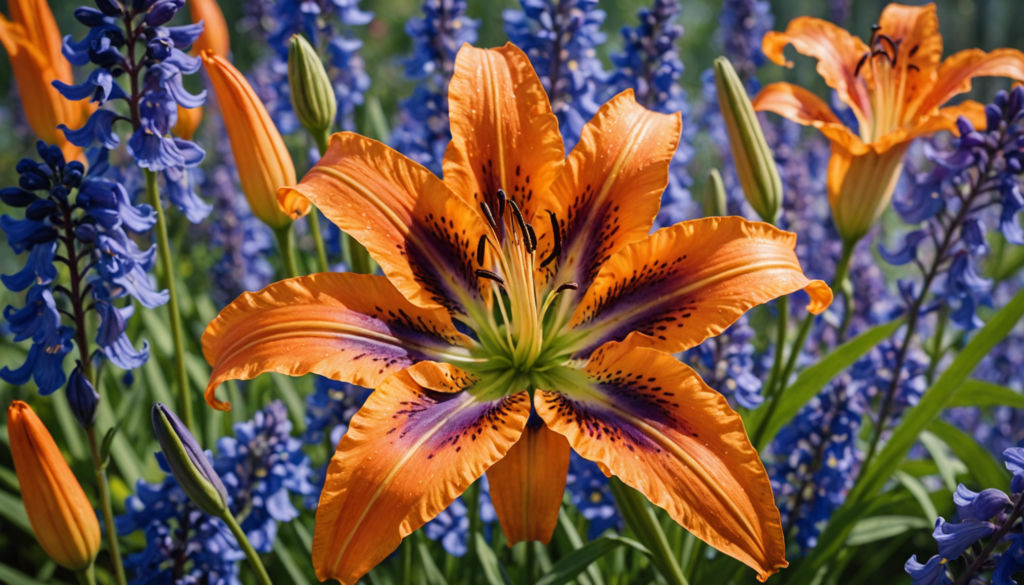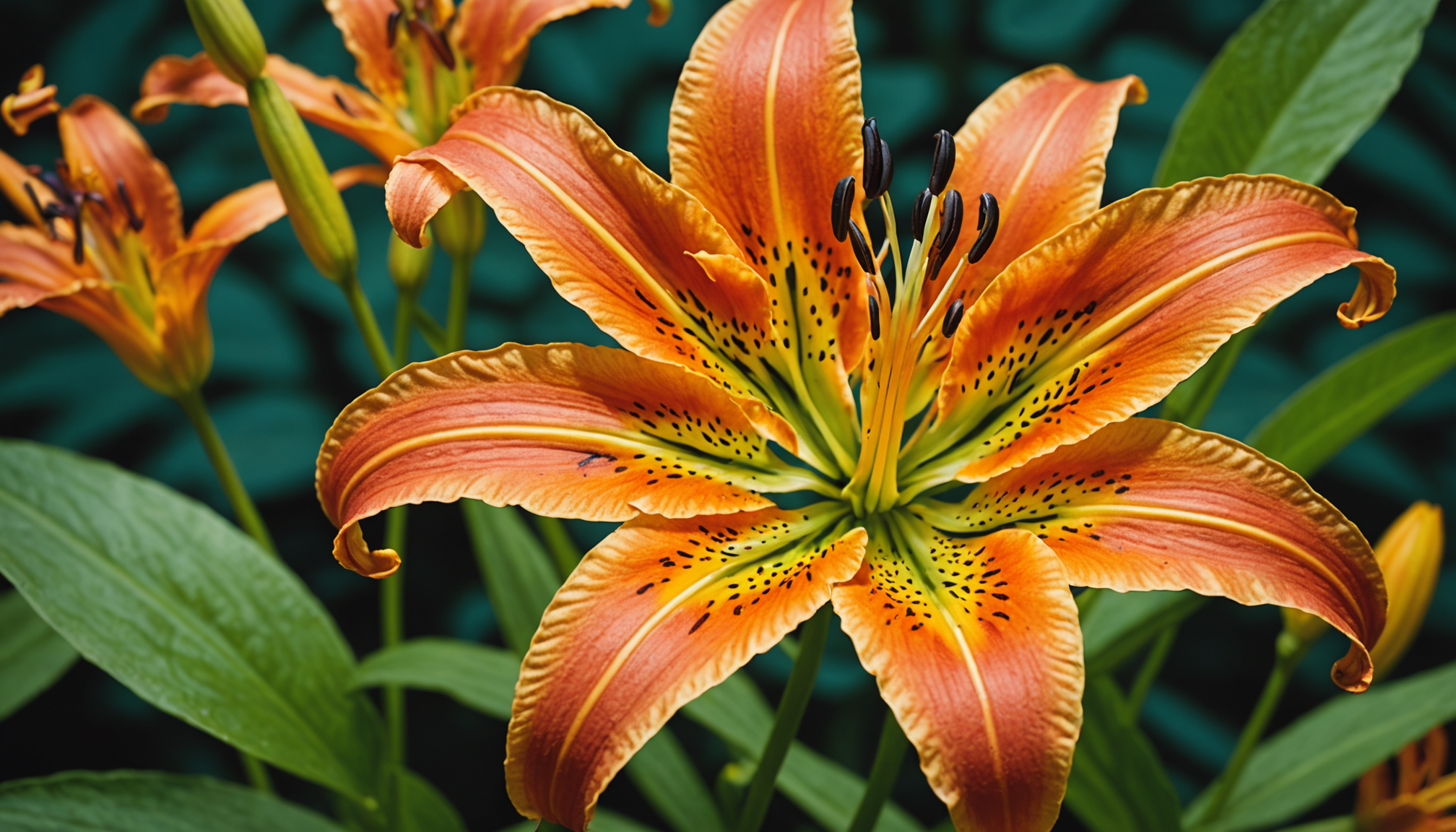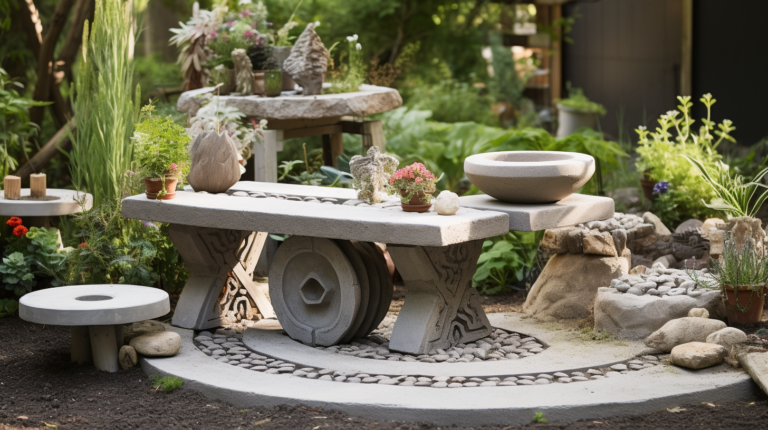Imagine walking through a summer garden and encountering the majestic tiger lily. Often referred to as the ‘tiger lily blue lily flower’ due to common confusion with other blue flowering plants, the true tiger lily boasts striking spotted petals and graceful stems reaching towards the sky. These stunning blooms have captivated gardeners for centuries, offering a perfect blend of dramatic colors and easy-care qualities that make them an excellent choice for both beginners and experienced plant enthusiasts.
In this guide, we’ll explore everything from choosing the perfect planting location to essential care tips that will help your tiger lilies thrive and create a show-stopping display in your garden space.
Tiger Lily Basics

What is a Tiger Lily?
The tiger lily or Lilium lancifolium is a tall perennial reaching 3–6 feet in height. Its petals recurve backward and display a striking appearance of black spots against orange backgrounds. These lilies thrive in a variety of conditions and come back year after year. They form small black bulbils along their leaf axils, which can be planted in well-draining soil for easy propagation. (USDA, Wikipedia)
- Orange flowers with black spots
- Curved-back petals
- Black bulbils in leaf joints
- Strong, upright stems
Benefits of Incorporating Tiger Lilies in the Garden
I appreciate tiger lilies because they require minimal maintenance and tolerate drier soil once established. Their bloom time in mid to late summer provides vibrant color when many plants start to fade. These lilies also attract pollinators and offer season-long interest. They fit well in borders, background color plantings, or mixed flower beds.
| Feature | Benefit | Best Application |
|---|---|---|
| Height | Adds dimension | Back of borders |
| Bloom Time | Late summer color | Extended garden interest |
| Propagation | Easy from bulbils | Natural spreading |
| Maintenance | Low effort | Busy gardeners |
| Wildlife | Attracts pollinators | Butterfly gardens |
How to Plant Tiger Lilies for Optimal Growth

Planting tiger lilies involves choosing a suitable site and preparing the soil to support healthy roots. These beautiful lilies can reach 2–5 feet tall and often come back year after year with minimal maintenance.
Best Time to Plant Tiger Lilies
Tiger lily bulbs perform well when planted in fall, about 6–8 weeks before the first frost. Soil temperatures should stay above 50°F (10°C) to encourage root growth. In cooler regions, spring planting in zones 3–8 is an alternative once the ground thaws and remains workable. Consistent warmth supports strong bulb establishment.
Soil Preparation for Planting Tiger Lilies
A well-draining site is vital. Loosen the soil to a depth of 12–15 inches and mix in organic matter to improve drainage and moisture retention. A light application of balanced 10-10-10 fertilizer can increase nutrient availability. Tiger lilies flourish in soil with a pH of 6.0–6.8, and a location that receives at least 6 hours of direct sunlight. Partial shade is also acceptable in warmer regions.
Planting Specifications
After placing bulbs with the pointed end facing up, fill the holes gently and water thoroughly. Adding a thin layer of mulch helps regulate soil temperature and reduces weed growth. In cooler zones, slightly deeper planting offers extra protection against freeze-thaw cycles. Proper timing and careful soil preparation allow these striking tiger lilies to display bright orange blooms, adding a touch of exotic color to any garden.
| Factor | Measurement | Purpose |
|---|---|---|
| Planting Depth | 4–6 inches | Root stability |
| Spacing | 8–12 inches | Air circulation |
| Row Width | 12–18 inches | Growth space |
| Soil pH | 6.0–6.8 | Nutrient uptake |
Propagating Tiger Lilies: From Bulbs to Blooms

I often expand my collection of tiger lilies by dividing mature bulbs or planting the small, black bulbils that appear along upright stems. Both methods add a touch of exotic color and produce beautiful lilies that come back year after year.
Methods of Tiger Lily Propagation
I consider bulb division the fastest route to new blooms. Once the foliage dies back each fall, I lift mature bulbs with a garden fork. Each bulb commonly forms two or more new plants if placed 4–6 inches deep in well-draining soil. These lilies can grow 2–5 feet tall (60–150 cm) and prefer at least 6 hours of direct sunlight per day.
| Propagation Method | Time to Bloom | Best Season |
|---|---|---|
| Bulb Division | 1 year | Fall |
| Bulbil Planting | 2–3 years | Late Summer |
Tips for Successful Bulb Division
I slice firm, healthy bulbs with a sterilized knife or spade and then plant them 6–8 inches apart. A balanced 10-10-10 fertilizer drives strong root growth in the active growing season. To avoid damaging new bulbs, I handle them gently and place the bulbs with soil that drains quickly. Cool, moist conditions help the bulbs stay undamaged before they establish new roots.
Common Propagation Challenges and Solutions
Soft rot can strike if soil stays soggy. I mix sand or perlite into dense garden beds to keep roots and soil from holding excess water. Removing any infected plant parts helps control botrytis blight, while aphid infestations are often controlled by handpicking or using insecticidal soap. The tiger lilies tolerates full sun to partial shade, so I choose a location with gentle air circulation to protect delicate blooms.
Essential Care and Maintenance Tips

Tiger lilies are hardy growers that reward consistent attention. They adapt to different climates but still need careful watering, fertilizer, pest checks, and winter protection. This approach preserves bright orange blooms and helps these beautiful lilies come back year after year.
Watering Requirements Throughout the Seasons
I keep the soil consistently moist during the active growing season. A deep watering once per week usually maintains enough moisture without waterlogging. Soil drainage is critical, so I reduce watering after blossoms can last their prime. At least 6 hours of direct sunlight also helps prevent fungal issues. (University of Minnesota Extension, Clemson Cooperative Extension)
Fertilizing Schedule and Best Practices
I rely on a balanced 10-10-10 fertilizer in early spring when new shoots appear. A second feeding occurs just before buds open, providing nutrients for tiger lilies and other Asiatic lilies. I avoid high-nitrogen products because they encourage weak growth. Fertilizing stops once the blooms fade.
Pest Management and Disease Prevention
Aphids and red lily beetles occasionally fall victim to hand removal or insecticidal soap. Spacing bulbs 12 cm apart promotes good air circulation and reduces the risk of botrytis blight. I remove any infected plant parts right away and keep garden tools clean to prevent the spread of disease.
| Issue | Symptoms | Treatment |
|---|---|---|
| Aphids | Sticky leaves, stunted growth | Apply insecticidal soap |
| Lily Beetles | Chewed foliage, bright red beetles | Hand-pick regularly |
| Botrytis Blight | Gray mold on stems or leaves | Improve air flow, remove debris |
Winter Care and Protection
I apply 2–3 inches of mulch once the ground freezes to protect bulbs with soil from harsh temperatures. Cutting stems to about 4 inches above ground prevents damage while marking each location helps in spring. Removing mulch as temperatures rise allows fresh growth and preserves healthy, upright stems.
Designing with Tiger Lilies

Tiger lilies are often misunderstood, since true tiger lilies (Lilium lancifolium) have bright orange blooms and no true blue variety exists. These tall plants grow 3–6 feet and show off distinctive, downward-facing petals. Their bold color works well in many garden designs and brings eye-catching drama to beds and borders.
Companion Plants for Harmonious Gardens
Tiger lilies pair well with pollinator-friendly flowers such as purple coneflowers (Echinacea) and black-eyed Susans (Rudbeckia). Ornamental grasses add texture and can steady the tall stems of these lilies. Group 3–5 bulbs, and space each one 6–8 inches apart to encourage a natural spread. This spacing prevents crowding and keeps the bulbs damage-free (Gardening Know How).
Creating Color Contrasts
Color choices can build on the bright orange hues of these stunning lilies. Purple or blue blooms (like Nepeta or Iris) provide dramatic contrast, while yellow flowers create a warm, harmonious palette. White tiger lily cultivars can highlight surrounding bold tones but remain less common. In windy spots, staking may be needed to support the upright stems and protect the delicate blooms.
Landscape Design Ideas
These lilies complement casual cottage gardens, woodland edges, and mixed perennial borders. They thrive in well-draining soil with at least six hours of direct sunlight in warmer regions. Planting them among lower-growing flowers, such as daylilies, helps fill gaps and provides continuous color. Plan for a spread of 1–2 feet per plant, and watch for common issues like aphid infestations or botrytis blight. Regular division every three to four years keeps them vigorous and ensures they come back year after year.
Conclusion
Growing tiger lilies is an exciting adventure that brings stunning beauty to any garden. With their striking orange blooms and easy-care nature, these remarkable plants are perfect for both new and experienced gardeners. Whether you choose to grow them from bulbs or try division methods, tiger lilies reward your efforts with spectacular summer displays that come back year after year.
Remember that successful tiger lily cultivation relies on well-draining soil, adequate sunlight, and proper spacing between plants. By following the care guidelines for watering, fertilizing, and pest management, you’ll create the perfect environment for these hardy perennials to thrive. As you explore different companion planting options and design possibilities, you’ll discover countless ways to showcase these magnificent flowers in your garden landscape.
FAQs
1. How tall do tiger lilies grow?
Most tiger lilies reach about 3–6 feet tall. They thrive in a variety of conditions during their active growing season and often produce multiple flowers per stem.1 Their bright orange blooms create an exotic color display that attracts pollinators.
2. What light conditions do they need?
At least 6 hours of direct sunlight per day for strong growth.2 Morning sun with afternoon shade works well in warmer regions. These beautiful lilies tolerate some shade but bloom best with ample sun.
3. When do they bloom?
They usually bloom in mid to late summer, and each blossom can last a few days. They come back year after year when given proper care.
4. When is the best time to plant tiger lily bulbs?
Fall planting, about 6–8 weeks before the first frost. This timing helps bulbs develop strong roots and survive winter conditions.
5. How deep and far apart should I plant them?
Plant bulbs 4–6 inches deep, with each bulb spaced around 6–8 inches. This spacing improves airflow around upright stems and helps prevent botrytis blight.







